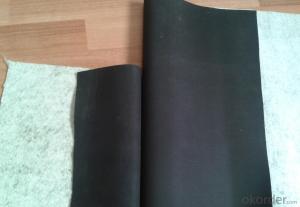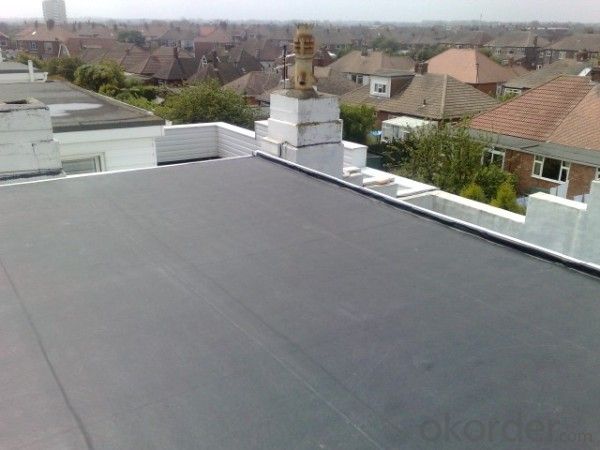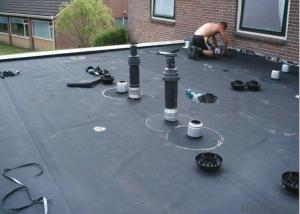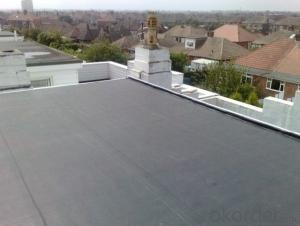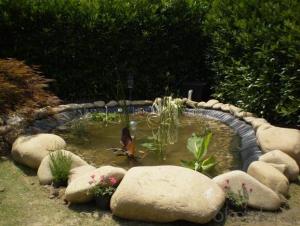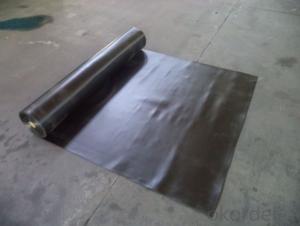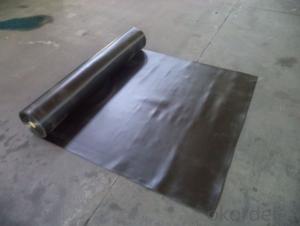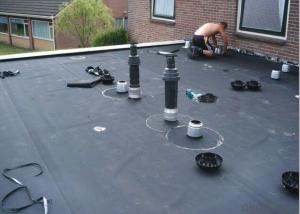EPDM Coiled Rubber Waterproof Membrane with Special Treatments
- Loading Port:
- Shanghai
- Payment Terms:
- TT OR LC
- Min Order Qty:
- 50000 m²
- Supply Capability:
- 5000000 m²/month
OKorder Service Pledge
OKorder Financial Service
You Might Also Like
EPDM Coiled Rubber Waterproof Membrane with Special Treatments
Description Of EPDM Coiled Rubber Waterproof Membrane with Special Treatments:
1. EPDM waterproof membrane is made from ternary ethylene-propylene rubber, which is for waterproofing of exposed and non-exposed applications.
2. EPDM waterproof membrane production adopts the world-advanced equipment of cold feeding extrusion and continuous vulcanization technology.
3. EPDM waterproof membrane is of high elasticity among high polymer waterproof materials and becomes a world-popular waterproofing material.
Main Features of EPDM Coiled Rubber Waterproof Membrane with Special Treatments:
1. Excellent physical and mechanical performance
2. High tearing resistance
3. Good deformation adaptability
4. High puncture resistance
5. High aging resistance
6. UV resistance
Specifications of EPDM Coiled Rubber Waterproof Membrane with Special Treatments:
| Material | EPDM Rubber |
| Size | 1.2m (width)*20m (length) or customized, weldable type 2.05m or 4m width |
| Thick | 1.2mm, 1.5mm, 2.0mm |
| Type | Vulcanized & Weldable |
| Pattern | Non-reinforced (homogeneous) |
| Certificate | ISO9001/14001 |
Applications of EPDM Coiled Rubber Waterproof Membrane with Special Treatments:
1. The substratum should be smooth, dry, clean, which can not have loosing and peeling phenomena.
2. Before application, clean up the basic level and eradicate the impurities.
3. Spread out the membrane on the substratum to loose sheet's stress. Use adhesive-glue to paint the substratum and the surface of membrane. When the adhesive is not sticky to hands, pave and press smoothly.
4. When pave the second volume of membrane, extrude 100mm of the edge of overlap of the first roll and do not paint with the adhesive. Pave the membrane on the substratum according to step so as to finish the whole pavement. When paving, do not tighten the waterproof membrane violently.
5. After that, use the special solvent to scrub the overlap joint. When it becomes fully dry , use the sheet glue to paint the both sides of the joint. Paint it again when it gets completely dry. Till the adhesive is not sticky to hands, press it smoothly and solidly.
6. Pay attention to fire prevention during application. Basement construction site shall be equipped with ventilation facilities



IMages of EPDM Coiled Rubber Waterproof Membrane with Special Treatments:




FAQ of EPDM Coiled Rubber Waterproof Membrane with Special Treatments:
1. What are we supplying?
We are specialized in producing Colorful Asphalt Roof Shingle, SBS/APP modified bitumen waterproof membrane, Self adhesive bitumen waterproof membrane, PVC waterproofing membrane, EPDM rubber roofing membrane, Single Component Polyurethane Waterproof Coating, and Spray Polyurea Waterproof Coating
.
2. How Many years experience do we have?
We have been exported to more than 20 countries in the past 15 years.
3. How long do we usually reply your request?
We always reply our customer within 24 hours.
- Q: Can a waterproofing membrane be used on brick surfaces?
- Yes, a waterproofing membrane can be used on brick surfaces. The membrane can be applied to protect the brick from moisture, water infiltration, and potential damage caused by water absorption.
- Q: How do waterproofing membranes prevent water leakage?
- Waterproofing membranes prevent water leakage by creating a physical barrier between the structure and the water. These membranes are made of materials that are impermeable to water, such as rubber, PVC, or bitumen. When applied correctly, they form a continuous and seamless layer that prevents water from seeping through cracks, joints, or other vulnerable areas. This barrier effectively stops water from infiltrating the structure, ensuring its protection against water damage and leakage.
- Q: Can a waterproofing membrane be used for fountains or water features?
- Indeed, fountains or water features can make use of a waterproofing membrane. Such membranes find widespread use across various applications, encompassing below-grade waterproofing, roofing systems, and even ponds. Their purpose is to establish a barrier against water infiltration, thereby safeguarding the underlying structure against water-related harm. In the context of fountains or water features, a waterproofing membrane serves to avert leaks and seepage, ensuring that the water remains confined within the intended boundaries. Furthermore, these membranes typically possess flexibility and durability, rendering them well-suited for deployment in areas subject to perpetual water exposure and potential movement.
- Q: Are waterproofing membranes resistant to oil and grease?
- Yes, waterproofing membranes are typically resistant to oil and grease.
- Q: Can a waterproofing membrane be used on modified bitumen roofs?
- A waterproofing membrane is capable of being utilized on modified bitumen roofs. In fact, it is quite customary to apply a waterproofing membrane on top of modified bitumen roofs in order to provide an extra layer of defense against water infiltration. This is particularly crucial in regions where heavy rainfall occurs or where the roof is frequently exposed to water. The waterproofing membrane serves to seal any potential cracks or openings in the modified bitumen roofing system, thereby preventing water from penetrating and causing damage to the underlying structure. Moreover, the waterproofing membrane can also bolster the overall durability and longevity of the roof by shielding it from the detrimental effects of moisture.
- Q: Can a waterproofing membrane be used for bridge abutments?
- Yes, a waterproofing membrane can be used for bridge abutments. Waterproofing membranes are commonly used in construction to prevent water infiltration and protect structures from moisture damage. Bridge abutments, which are the supports at either end of a bridge, are particularly vulnerable to water damage due to their proximity to water bodies and potential exposure to groundwater. Applying a waterproofing membrane to bridge abutments can help to create a barrier against water penetration, preventing potential damage to the structure. The membrane is typically installed on the abutment walls and extends below the ground level to ensure complete protection. Waterproofing membranes are designed to be durable and flexible, allowing them to withstand the movement and settling that can occur in bridge abutments. They are often made from materials such as bitumen, PVC, or modified bitumen, which provide excellent resistance to water and other environmental factors. By using a waterproofing membrane on bridge abutments, engineers and contractors can ensure the longevity and safety of the structure. It helps to prevent moisture-related issues such as concrete deterioration, corrosion of reinforcing steel, and the development of cracks and leaks. Additionally, the membrane can also act as a vapor barrier, reducing the potential for condensation and moisture buildup within the abutments. In conclusion, waterproofing membranes are an effective solution for protecting bridge abutments from water damage. They provide a reliable barrier against water penetration, ensuring the structural integrity and durability of the bridge.
- Q: Can a waterproofing membrane be used for power plants?
- Yes, a waterproofing membrane can be used for power plants. Waterproofing membranes are commonly used in power plants to protect the structural elements and equipment from water damage and leakage. These membranes are designed to provide a durable, watertight seal that can withstand the harsh conditions and high moisture levels typically found in power plant environments. Additionally, they also help in preventing corrosion and extending the lifespan of the power plant infrastructure.
- Q: Does a waterproofing membrane require any curing time before it can be exposed to water?
- Yes, a waterproofing membrane does require a curing time before it can be exposed to water. The curing time allows the membrane to fully bond and develop its maximum strength, durability, and waterproofing properties. The exact curing time can vary depending on the type of membrane and the manufacturer's instructions. It is important to follow these instructions to ensure that the membrane is properly cured and can effectively protect against water intrusion. Failing to allow sufficient curing time can compromise the effectiveness of the membrane and may lead to leaks or other issues. Therefore, it is recommended to wait until the specified curing time has elapsed before exposing the waterproofing membrane to water.
- Q: Can a waterproofing membrane be used for retaining walls?
- Yes, a waterproofing membrane can be used for retaining walls. Retaining walls are structures designed to hold back soil or water, and it is essential to prevent water penetration to avoid potential damage or structural failure. Waterproofing membranes are commonly used to provide a barrier against water infiltration, thereby protecting the retaining wall and ensuring its stability over time. These membranes are typically made of materials like rubber, PVC, or bituminous compounds, and they are installed on the inner side of the retaining wall to prevent water from seeping through. Additionally, some waterproofing membranes also offer additional benefits such as resistance to root penetration, UV protection, and flexibility to accommodate movement in the retaining wall. However, it is important to note that the specific type of waterproofing membrane used should be selected based on factors such as the type of retaining wall, the level of water pressure, and local climate conditions. Consulting with a professional engineer or contractor is recommended to ensure the appropriate waterproofing solution for your particular retaining wall project.
- Q: How to distinguish whether the waterproofing membrane is polyester tires?
- Waterproof membrane requirements have good water resistance, stability of the temperature change (high temperature does not flow, no blistering, not confuse; low temperature does not brittle crack), a certain mechanical strength, extensibility and resistance to fracture, to There is a certain degree of flexibility and anti-aging and so on.
Send your message to us
EPDM Coiled Rubber Waterproof Membrane with Special Treatments
- Loading Port:
- Shanghai
- Payment Terms:
- TT OR LC
- Min Order Qty:
- 50000 m²
- Supply Capability:
- 5000000 m²/month
OKorder Service Pledge
OKorder Financial Service
Similar products
Hot products
Hot Searches
Related keywords
